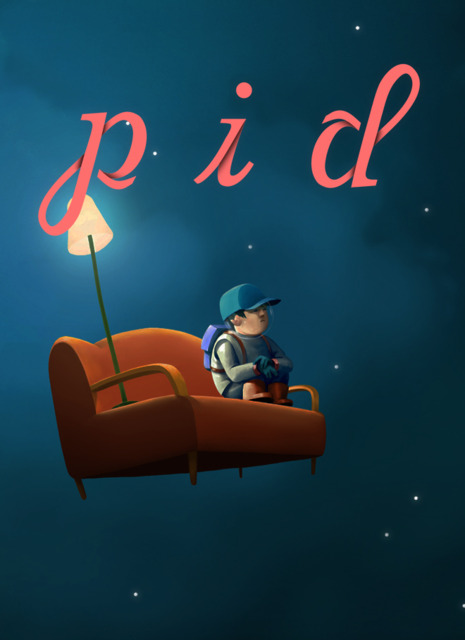Pid Review
When I saw there were 0 reviews for Pid up I thought I'd upload it here. This review was originally posted at my blog, Ramblings of a MAD Man, and has been reformatted to work with GiantBomb's user reviews but has otherwise received no edits. I appreciate feedback so long as it's constructive, I'm always looking to improve my writing. Enjoy.
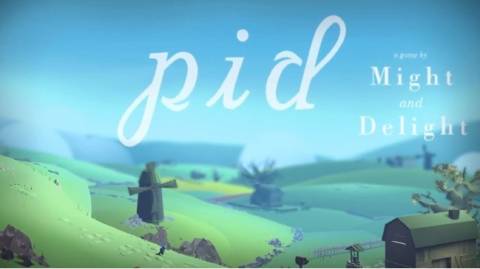
I’ve mentioned in a number of my reviews that certain elements immediately draw my attention. This is usually a reference to a certain visual aesthetic I find very attractive for one reason or another. This doesn’t mean it needs to have an insane polygon count and hyper-sexualized females, it just needs to be something that makes me go “I want to play that.” When it came to seeing Pid‘s world premiere trailer live on GiantBomb the first thing that tickled my senses was the music. I instantly fell in love with Pid when I heard the guitar and piano kick in. Soon to follow was a very charming and simple visual design of muted colors, reminiscent of pastels or water-colors, that lent itself well to a chill and relaxed theme that is pervasive throughout the game. I actually find it almost sadistic because the game can be quite challenging/frustrating at times.
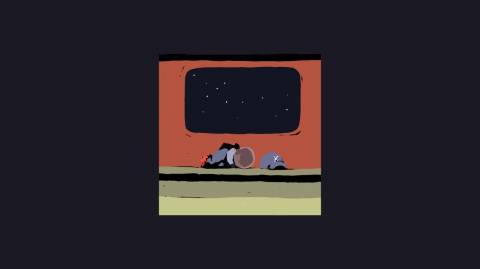
Pid is about Kurt, a young space-school kid who happened to fall asleep on the space-bus on his way home and ended up reaching the end of the road: a strange planet where everyone seems to be waiting for something. Kurt’s journey will have him traversing a number of different areas with the goal of finding a way to get home. You’ll soon discover that things are not so good on this planet and an unusual corruption, noted by different colored NPCs/enemies, has spread to its inhabitants and that the planet is in a state of political turmoil. As Kurt makes his way to the end to find his way home there are a few rather touching story sequences and a nice reveal about just who is helping and why everything went so horribly wrong in what was once a peaceful, happy world.
Not too far along in your side-scrolling journey you find your way into a vault with an amazing power locked inside: glowing beams of light. This power is what allows Kurt to make his way through the dangers of this planet and find his way home. Pid is a puzzle/platformer that revolves around what can best be described as gravity puzzles. These beams of light that Kurt can use are gravity beams that will lift or propel Kurt, items and some foes, along their respective paths. You can have 2 placed at a time and by throwing a 3rd down you’ll overwrite the 1st and so on; they also last a limited amount of time.
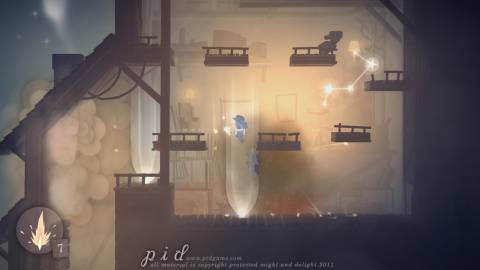
The majority of the time you’ll be making your way through the levels you’ll need to avoid being seen. There are cameras and humanoid enemies that have sight and it’s game over should you be seen. Depending on the color of the enemy, as I hinted before, you’ll have to take different approaches. The NPCs you’ll be interacting with for story beats are going to be Yellow, they’re friendlies and victims of the war going on in the world. Those that have been corrupted will be either Blue or Red and this will dictate how to best approach them. Blue enemies will not be effected by the beams Kurt can place, similarly beams cannot be placed on blue surfaces. Red enemies can be carried away under the beams’ power and also can be temporarily removed from the field by closing a beam with a red enemy in it; they’ll reappear shortly after closing the beam but it’s more than enough time for Kurt to make his way past.
When not going up against enemies with sight it plays out like any traditional game, where hitting an enemy results in damage, and just like with being spotted it usually results in death. This might sound harsh, but everything in the game will take Kurt out in 1 hit without body armor items. This encourages safe play, good planning, and quick reflexes in order to find the best path through a level.
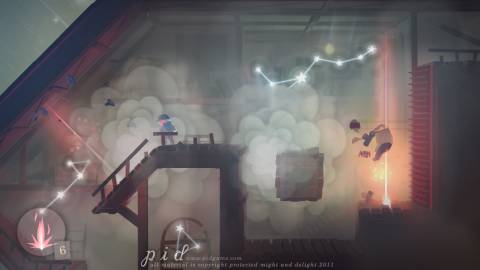
Though the beams alone will allow you to get through most of the game, Kurt will come upon a number of very helpful items to let him deal with enemies and get gain access to secret areas such as: body armor, bombs, lasers, explosive beams, and more. Along the way you’ll have collected some amount of stars which act as the game’s currency should you choose to purchase items you’ve run out of. Save for boss fights or accessing hidden areas these items aren’t necessary to use. However those planning a speed run will find them to be essential. You’ll also get a slingshot that changes the way Kurt deploys his gravity beams. Normally he throws them a few feet ahead and this can be done anywhere at any time, but the slingshot allows Kurt to very precisely, and at great distance, shoot a beam anywhere in line-of-sight when standing still.
Occasionally while playing Pid I got a sort of SuperMeatBoy vibe because there is a decent amount of trial and error involved; also the whole instant-death thing (for the most part). Most levels are broken up into small scenes with frequent checkpoints but play out very linearly. I mentioned before that for the most part, everything is a 1-hit kill. So finding the best path, where the beams should go, how to deal with or avoid enemies, etc. is necessary. This also makes for some incredibly satisfying sequences where you’ll run through an entire area barely ever touching the ground, just floating from beam to beam dropping bombs with such fluidity of movement that you wish you had recorded it. This is most apparent in two of the boss-fights where you’ll just run and use beams to navigate your way through a relatively confined space while being chased by something Indiana Jones style. These were my absolute favorite sequences because when you got it right, it was beautiful.
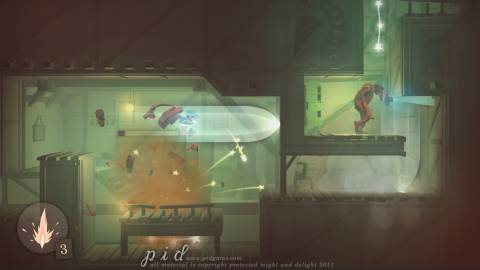
There are a number of areas and sequences throughout the game that require that same level of dexterity and timing that will become second nature once you get the hang of how far a toss goes, how certain enemies behave, and how close to the ground you can drop a beam while falling without hitting the spikes. Though simple to learn the various mechanics and tactics available in Pid they are difficult to master. It will take about 8-10 hours to complete on your first playthrough as you learn the mechanics and solve your way through the environmental puzzles. After beating it once you’ll unlock Hard mode which changes things up a bit and most definitely increases the challenge.
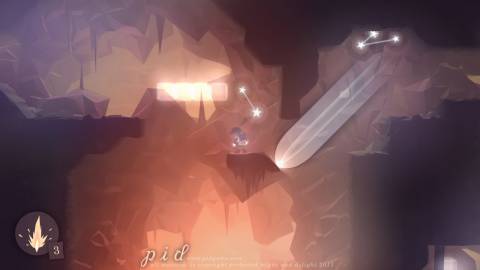
Pid‘s strongest element is its tone. The game is very relaxed, save for the moments of extreme frustration when you miss a beam or a jump for the 30th time, supported by great jazz music, charming designs, and a beautiful color palette. That isn’t to say that the puzzles aren’t challenging, I only mean to say that the most impressive features of the game are the sights and sounds. The levels are designed rather well with a variety of themes as you progress, from the backstage of an opera house and underground mazes to skyscrapers and the moon. However within each level you’ll run into a lot of familiar enemies and obstacles with the introduction of new elements coming to a startling halt not too far into the game.
My only real complaint for Pid is that the gameplay really doesn’t vary as much as I’d have liked. The items aren’t necessary beyond very specific instances and the puzzle variations are limited. The most inventive sequences are definitely the sparsely placed boss fights but elsewhere inspiration seems to be lacking. You’ll quickly experience all the puzzle elements that will be encountered throughout the game and when some new feature gets added it either is completely forgotten about afterwards or it just becomes a constant thing. There are never any twists added to the beam itself, other than the slingshot, that I feel was a missed opportunity to expand the puzzle elements. In some of the later levels you’ll encounter pipes that reverse the flow of the beams and they disappear just as fast as you were introduced to them. Simply giving this power to the beam via some alternate fire might have been very interesting to change up the mechanics.
I never tried my hand at the co-op and quite frankly I think it’s a horrible idea. The amount of precision timing for many sequences throughout the game do not lend themselves well to be coordinated by multiple people. What I would have liked to see instead of a co-op would have been a level editor. Being able to make levels like the two boss encounters where you’re moving fast with well-timed beam placement to get up/over/through obstacles would have extended my playtime by a significant amount.
I’ve replayed Pid partially and realized that I didn’t want to replay it for the puzzles so much as experience the story and the music and get myself dug deep into the wonderful atmosphere. It doesn’t do anything revolutionary or set any new benchmarks, but for the price it’s a fine game that most people will have a good time with.
